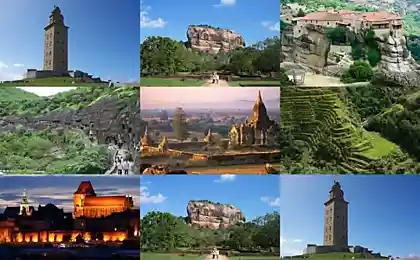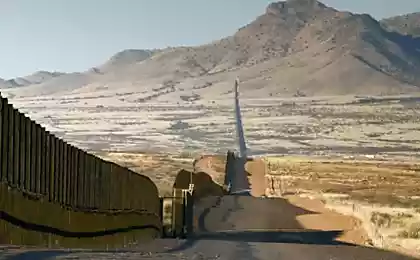2508
Terrible prehistoric ancestors
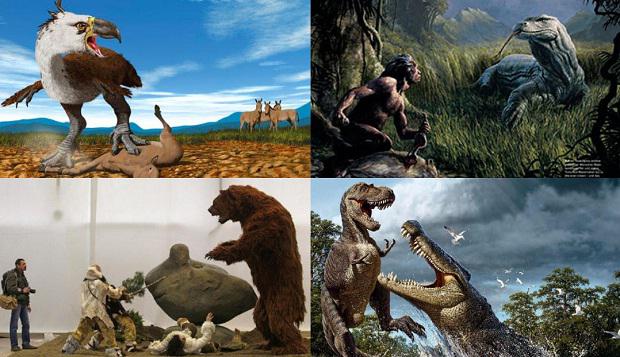
Today man is the dominant predator on the planet. Nevertheless, we have taken this position for a relatively short period of time - the earliest known representatives of human Homo habilis, first appeared about 2, 3 million years ago.
Despite the fact that we are dominating the animals to this day, many of these animals are extinct ancestors, which were much larger and more powerful than the ones with which we are familiar. The ancestors of these animals looked like creatures of our worst nightmares. Frightening is that if humanity will disappear, or simply lose their dominance - these creatures, or similar ones, have the potential to restore the right to exist. 1. megatherium Today, sloths slowly climb trees and do not pose a threat to animals that live in the Amazon. Their ancestors were the complete opposite. In the Pliocene epoch, megatherium giant sloth was in South America, he weighed up to four tons and up to 6 meters in length from head to hvosta.
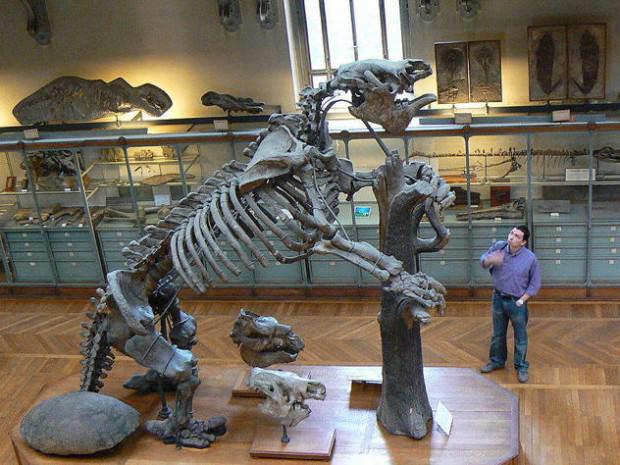
Although they mostly moved on four legs, footprints show that he is able to stand on two legs, in order to reach the leaves of tall trees. It was the size of a modern elephant, and yet was not the biggest animal in its habitat!
Archaeologists suggest that megatherium was a scavenger, and stole carcasses of dead animals of other carnivores. Megatherium was also one of the last giant mammals of the Ice Age before their complete disappearance. Their remains appear relatively late in the fossil record, the Holocene - the period in which saw the rise of humanity. It makes a person most likely culprit for the disappearance of Megatherium. 2. Gigantopitek
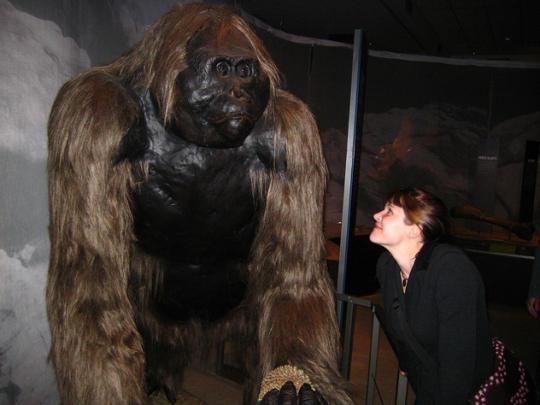
When we think about a giant ape, we usually think of the fictional King Kong, but the giant ape actually existed for a long time. Gigantopithecus - a monkey, which existed around the time of the 9 million to 100 thousand years ago, about the same period as the other members of the family of hominids.
As fossils shows that the special type of Gigantopithecus were the largest apes that ever existed, standing they reached nearly 3 meters and weighed a ton of floor. Scientists have not been able to determine the cause of the extinction of the giant ape. However, some crypto-zoologists suggest that the "observation" of Bigfoot and the Yeti can be associated with a lost generation of Gigantopithecus. 3. Reinforced dunkleosteus fish (lat. Dunkleosteus) was the largest of the prehistoric crustacean fish placoderms (lat. Placodermi). Her head and chest were covered by articulated armored plate. Instead of teeth, these fish possess two pairs of sharp bony plates that formed klyuvnye strukturu.
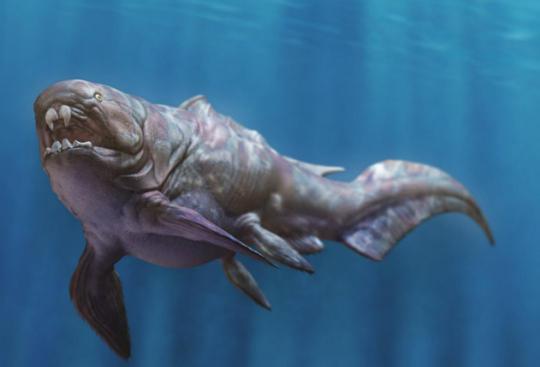
Dunkleosteus probably consumed one placoderms who have had the same bony plates for protection, their jaws powerful enough to cut and pierce armored prey. One of the largest known specimens found, was 10 meters long and weighed four tons, making it one of the fish that you just do not want to catch a spinning!
This fish was not picky eating habits, eating fish, sharks and even the fish of his family. But probably they have suffered from indigestion provoked poluperevarivavshihsya fossil remains of fish. Scientists from the University of Chicago concluded that Dunkleosteus had the second strongest bite among fish. These giant armored fish have become extinct during the transition from the Devonian to the Carboniferous period. 4. Bird-terrorist Most flightless birds today - an ostrich or a penguin, for example, do not carry the danger to humans, however, was a flightless bird that terrorized zemlyu.
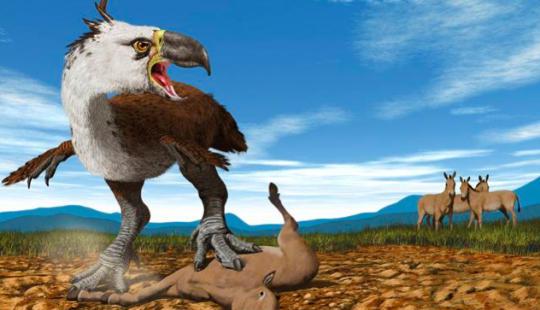
Phorusrhacidae, also known as "bird-suicide" and the predatory species of flightless birds that were the largest species of predators in South America during the period from 62 million to 2 million years ago. They reach about 1-3 meters in height. Prey birds terrorists were small mammals ... and by the way the horse. They used their massive beaks to kill two ways: picking small prey and throwing her to the ground, causing a pinpoint strikes on important parts of the body.
Although archaeologists still not fully determined the causes of extinction of this type, the last of its fossils appear at about the same time as the first humans. 5. Haast's eagle Birds of prey always affects the human psyche. Fortunately, we are much more than the largest eagle. However, once there were birds of prey that were large enough to hunt a man.
Haast's eagle lived on the South Island of New Zealand, and was the largest of the famous eagles, weighing up to 16 kg, with a wingspan of 3 meters. Prey yavlyalis140 pound flightless moa birds, which were unable to protect themselves from the impact force and speed of the eagles, which reached speeds of up to 60 km chas.
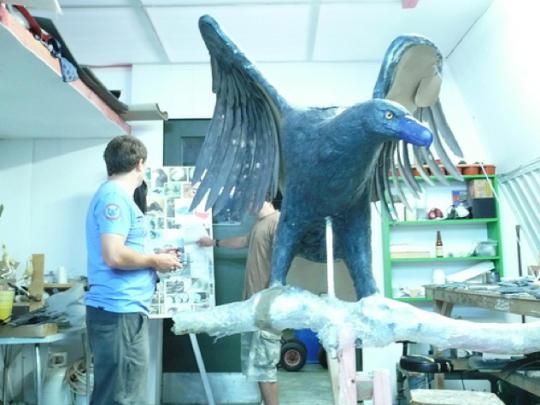
Legends of the one of the first Maori settlers say that the Eagles could pick up and eat small children. But first settlers in New Zealand hunted mainly on large flightless birds, including all kinds of moa, which ultimately led to their disappearance. Loss of natural production caused the extinction of Haast eagle when his natural power supply was exhausted. 6. Giant lizard ripper Today, the Komodo dragon - and the largest reptile terrible lizard on the planet, but it would be insignificant compared with its ancient ancestors. Megalania, also known as the "Giant Lizard ripper" - a very large lizard. The exact proportion of the creatures were different, but recent studies have shown that the length of Megalania was about 7 meters and a weight of 600 to 620 kg, making it the largest terrestrial lizard from all suschestvovavshih.
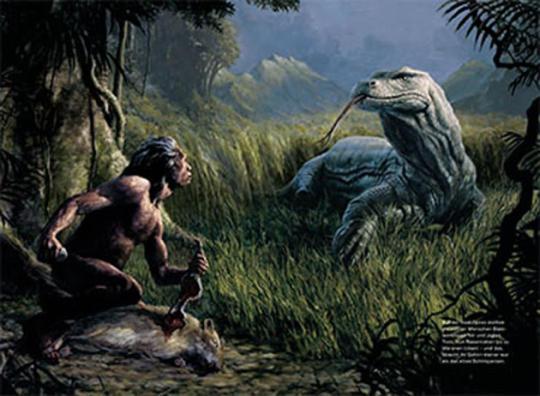
His diet consisted of marsupials: kangaroos and giant wombats. Megalania belongs to a clan toxicofera, possessing poison-secreting glands, the largest lizard poisonous vertebrate ever known. Although we could not conceive of such a size dinosaurs living in the province, the first Australian Aborigines may encounter with the living Megalania. Kind of most likely extinct, when the first settlers hunted Megalania using them for food. 7. The short-faced bear Bears are one of the largest mammals in the world, with the polar bear, even held the title of the largest of all the predators on land. Arctodus - also known as the short-faced bear, lived in North America during the Pleistocene. Short-faced bear weighed about one ton and standing on its hind legs reach a height of 4 to 6 meters, making the short-faced bear the largest mammal predator ever suschestvoval.
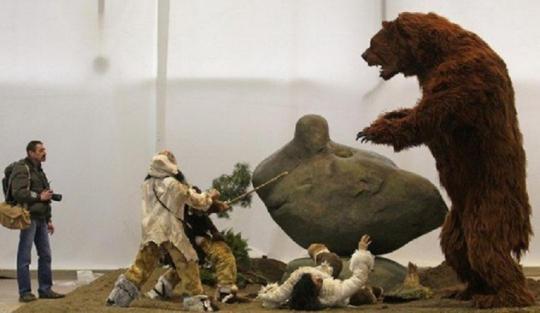
Although the short-faced bear was very large predator, archaeologists have found that it was actually the scavenger. Being a scavenger, however, is not a bad idea, especially when you are struggling with saber-toothed tigers and wolves for food. Like most other large Pleistocene animals, short-faced bear lost much of their food sources with the arrival of humans. 8. deinosuchus Modern crocodiles - living dinosaurs, but there was a time when crocodiles were hunted and ate the aforementioned dinosaurs. Deinosuchus (lat. Deinosuchus) - is an extinct species related to alligators and crocodiles that lived during the Cretaceous period. Deinosuchus translated from Greek as "terrible crocodile» .
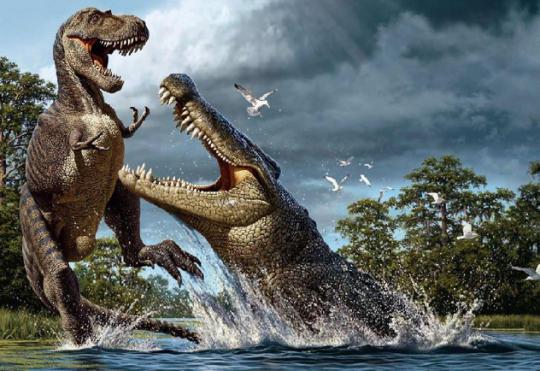
This crocodile was much larger than any of the modern, up to 12 meters and a weight of ten tons. His appearance he was like their smaller relatives, more reliably established teeth for crushing, and back covered with armored plates of bone.
The main prey deinosuchus were big dinosaurs (who can still boast of?), And in addition thereto sea turtles, fish and other unfortunate victims. Potential evidence of danger deinosuchus come from Albertosaurus fossils. This hole samples from the teeth and deinosuchus Tirranozavra Rex, which means that there are great chances that the two violent predator involved in bloody battles. 9. titanoboa No being is more fear in the human psyche than a snake. Today, the largest snake is the reticulated python, its average length of 7 metrov.

In 2009, archaeologists made a shocking discovery in Colombia by comparing the shapes and sizes of fossilized vertebrae of modern snakes ancient snake titanoboa reached the maximum length of 12 to 15 meters and weigh up to 1,100 kg, making it the largest snake ever to crawl on the planet. Since this is a recent discovery, little is known about titanoboa, but we know one thing: the 15-meter snake scared the whole world, whether or not there is a phobia. Megalodon 10. Until 1975, phobias most people concerned mainly snakes and spiders. That all changed when the film Jaws was released, the antagonist of the film appeared the great white shark (non-existent), which resulted in a fit many people and did not allow to go into the ocean. Today, the largest great white sharks usually reach 6 meters in length and weigh 2200 kg. However, once it was a shark, which was twice the largest modern great white akul.
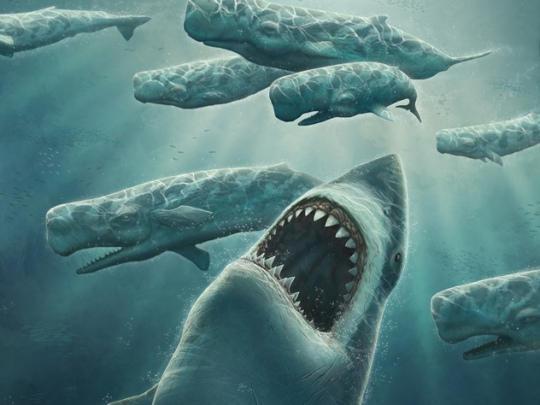
Megalodon - means "big tooth" - a shark that lived from 28 to 1, 5 million. Years ago. All of Megalodon was with the prefix "mega": his teeth were 18 cm and the fossil remains show that this giant shark reached a maximum length of 16-20 meters. While today, great white sharks hunt seals, megaladon have eaten whales. Scientists suggest that this species became extinct due to oceanic cooling, falling sea levels and reduce food sources. If there was a chance that megaladon existed in our time, a man would not have had access to the sea. However, in a giant ocean, the abyss can be hiding a great white shark, and there is always a chance that something like megaladona return to the world.
Source: daypic.ru/animals/168597









